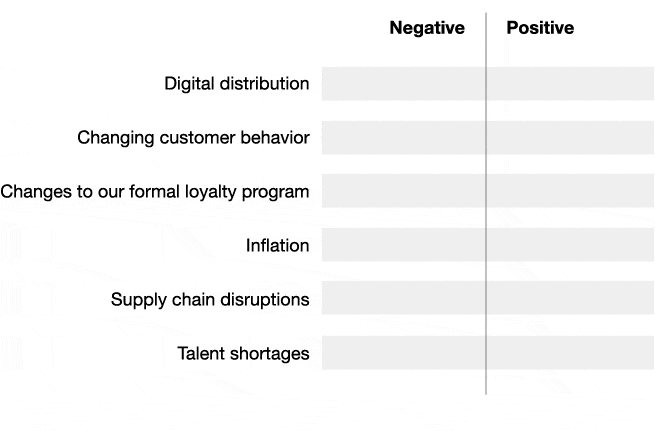{{item.title}}
{{item.text}}

{{item.title}}
{{item.text}}
As companies continue to navigate market volatility, securing and expanding their relationships with their customers is perhaps more important than ever. Short-term pressures such as inflation and uncertain supply chains can push some leaders to reactively focus only on retention. But if you don’t understand how your customers make loyalty decisions throughout their journey with your brand, your business won’t be able to turn loyalty into real growth.
PwC surveyed more than 400 executives who are either responsible for or share influence regarding customer loyalty or retention decisions. We wanted to learn how well their companies are capitalizing on customer loyalty opportunities as they address current challenges. The PwC Customer Loyalty Executive Survey 2023 followed our May 2022 survey of more than 4,000 consumers in the United States. Taken together, the two surveys can help illustrate openings, moments and other pivotal points when you can increase customer engagement with your brands and improve the chances that they’ll not only stay but develop deeper bonds that turn loyalty into a growth engine.
Companies often define loyalty differently than consumers do. While businesses may consider a wide range of customer actions as evidence of loyalty, consumers have a narrower view of what it means to be loyal to a brand. Understanding this discrepancy can help you better focus loyalty efforts and investments.
Executives and consumers differ on when brand loyalty is won. More than twice as many executives (25%) as consumers (11%) believe that good customer service is the key to winning loyalty, while only half as many executives (23%) as consumers (46%) believe that high-quality products are key.
There’s a big difference between executives and consumers on why customers leave a brand. Executives blame price changes or competition, but many consumers cite bad experiences with products or customer service. This “price-experience gap” reveals a disconnect on what can drive loyalty. To keep customers, focus on providing great experiences, not just low prices.
Bridging the gap in why customers leave can be critical as your company invests more in loyalty efforts. Nearly two-thirds (63%) of executives say their company’s loyalty program budget increased in the latest planning cycle, and businesses think of loyalty as a growth engine just as much as a retention tool.
Retention and growth can be crucial in light of the contrasting views on COVID-19’s impact on customer loyalty. While 61% of executives believe customers are more loyal now than before the pandemic, only 20% of consumers agree.
Personalized experiences can help drive loyalty, but some companies may not be delivering the right experiences in moments that matter. For instance, easy or fast access to products or services topped the list of what businesses provide to customers at 47%, but only 22% of consumers said that was most important in a personalized experience.
Executives and consumers largely agree on why a person will likely keep using or buying from a brand. The quality, reliability and consistency of products or services (executives 46%, consumers 48%) and good value for the price (executives 42%, consumers 53%) are the top two reasons by far on each list.
But when it comes to the effects of the pandemic, some businesses are overconfident about loyalty and may be taking customer relationships for granted. Among executives, 61% say their customers are more loyal today; that number was higher in media and entertainment (79%), technology (75%) and consumer products (69%). But only 20% of consumers told us they’re more loyal to brands they bought from or used before the pandemic. By comparison, 75% of consumers said there’s been no change in their loyalty, while only 26% of executives say there’s been no change.
As for other impacts on loyalty in the last two years, the top negatives are familiar from news headlines: inflation, supply chain disruptions and talent shortages. The pandemic was actually cited by more executives as having a positive impact on loyalty (45%) than negative (33%). The developments most cited as having a positive impact on customer loyalty were digital distribution channels (such as direct-buy links from social media), changing customer behavior and changes to their formal loyalty programs.


On average, executives told us their current annual budget for loyalty is about 5% of company revenue, with higher percentages in media and entertainment and consumer markets and lower percentages in consumer products. Loyalty efforts include a formal loyalty program at 70% of businesses, with retail (82%), tech (81%) and consumer products (80%) most common. In addition, 63% of executives say budgets for those formal programs increased in the most recent planning cycle.
Those investments make sense when you consider that an overwhelming majority of respondents — 91% — say they agree that their formal loyalty program should provide more rewards or benefits for members. Differentiation also may be a goal. Even as many executives touted their loyalty program’s unique benefits compared to competitors, 80% said their program is similar to others in their industry.
Stronger bonds with customers can help drive longer and deeper relationships. While frequency of engagement can vary by industry — supermarkets versus airlines, for example — seven out of ten executives say they define an active customer as one who has been active for 30, 60 or 90 days. Only 11% say 12-month active, and only 2% say 24-month active. With customer lifetime value becoming a more critical metric at many — and many types of — companies, expanding engagement and creating long-term loyalty beyond a few months of activity can be critical.
So how are companies approaching loyalty-building opportunities and challenges? Customer service is by far the most common department responsible for shaping customer loyalty goals (39%), more than twice as much as marketing (17%). No other department topped 10%. The top executive priorities for activating loyalty are enhancing customer service (61% say it’s a high priority) and personalizing the customer experience (61%).
There’s no question that customer service is important, especially in sectors where that interaction can go beyond customer retention to help win a bigger share of their wallets. And 32% of consumers told us in May 2022 that they stopped using or buying from a business after a bad experience with customer service. But that wasn’t No. 1 among consumers, as 37% said they left after a bad experience with products or services. In many cases, customer service can help handle immediate issues, but that’s often too far downstream in the customer relationship to solely drive loyalty.
Loyalty efforts should focus on several different points in a customer’s journey, including when you can win loyalty. But executives’ top response to when customer loyalty is won or lost was again centered around good customer service, while consumers — by a huge margin — said when they used a product or service and liked the quality was the key point when deciding to stick with a brand.
Personalization can help you maintain and grow customer loyalty, but many businesses are still searching for the most effective mix. Consider what each group says about personal data. First, companies we surveyed said they generally collect more types of data to create personalized experiences than what consumers tell us they’re willing to share. Second, while there’s alignment on basic contact info and personal identifiers — email, birthday and sex — consumers are less open to more direct contact and sharing usage and location data.
A bigger disparity exists in personalized experiences themselves — namely number versus relevance. Companies in our executive survey on average provide four types of personalized experiences, led by easy or fast access to products or services (47%), loyalty programs with flexible rewards (43%) and discounts or rebates on products customers regularly use (40%). Consumers also said discounts and rebates (48%) and flexible loyalty programs (43%) were among the most important parts of a personalized experience, but nothing else came close.
PwC surveyed 410 executives across a range of consumer-facing companies between October 15 and November 22, 2022. Respondents in the online survey included C-suite officers, business owners, upper management, directors and corporate board members in the US. Roughly two-thirds (64%) of respondents have sole responsibility for business decisions on customer loyalty or customer retention, and one-third (36%) share influence with others regarding business decisions on loyalty or retention.
The PwC Customer Loyalty Executive Survey 2023 follows the PwC Customer Loyalty Survey of 4,036 consumers in the US in May 2022. Respondents in that online survey were adults 18 and older, with demographic weighting to achieve census representation on age, gender, race, US region, income, employment status and marital status.




